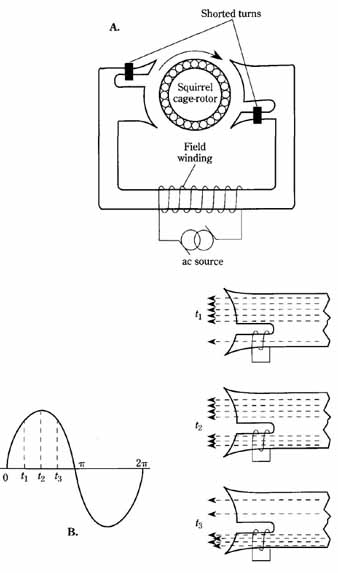AMAZON multi-meters discounts AMAZON oscilloscope discounts
.The basic construction features of the shaded-pole induction motor are illustrated in FIG. 13A. As can be seen, the poles are divided into two segments. The smaller segment of each pole has a shorted turn consisting of a heavy copper strip or bar. The growth and decline of magnetic flux is not uniform across the pole faces, as it’s with ordinary pole structures having uniform geometries. Because of the shorted turn, the flux in the small segment always opposes the flux change occurring in the large segment. This is in accordance with Lenz’s law—current is induced in the shorted turn, and the field thus developed opposes the inducing field (that is, the field in the large segment). This produces a delayed field in the small segment. The net result when the pole structure is excited from a sinusoidal source of current is a sweeping action of flux across the faces of the poles as shown in FIG. 13B.
Because both poles are behaving in this fashion, but in alternate sequence, the rotor of the motor experiences a rotating field. Like other motors illustrated in this book, the shaded-pole type can have many pairs of poles, the two-pole structure is shown for the sake of simplicity. The direction of rotation is toward the shaded-pole segment. In most of these motors, the shorted turn is an integral feature of the pole structure and the motor cannot be reversed. However, special models are manufactured in which the poles have “shaded” segments at each pole tip; these, instead of being short-circuited, are electrically switchable.
Although this appears to be a clever way of creating a rotating field from a single- phase field excitation, such motors have relatively weak starting and running torques. Also, their efficiency and power factor are low. Thus, the shaded-pole motor is made only in small sizes and is suitable for only low-torque applications such as phonograph drives, fans, and various instrumental purposes. On the plus side, its simplicity and reliability can hardly be surpassed. There are no internal switches, and the stalled-rotor current is not appreciably greater than its rated full-load current.
The shaded-pole motor can tolerate large amounts of slip before breakdown torque is experienced. It, therefore, is well suited to speed control by variation of applied volt age. As with all induction-type motors, however, synchronous speed can be approached but not attained. The characteristics of a small shaded-pole motor are shown in FIG. 14.
-- --

FIG. 13 The shaded-pole induction motor. A. The basic structure of
a shaded-pole induction motor. B. The flux-sweeping action of the shaded
pole.
-- ---

FIG. 14 Characteristics of a small shaded-pole induction motor.
---- --